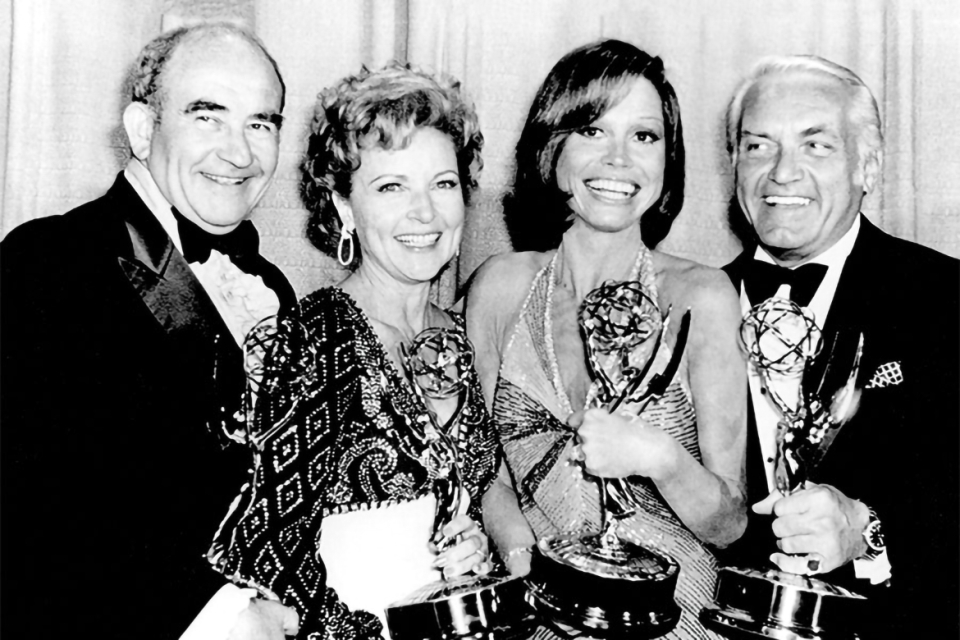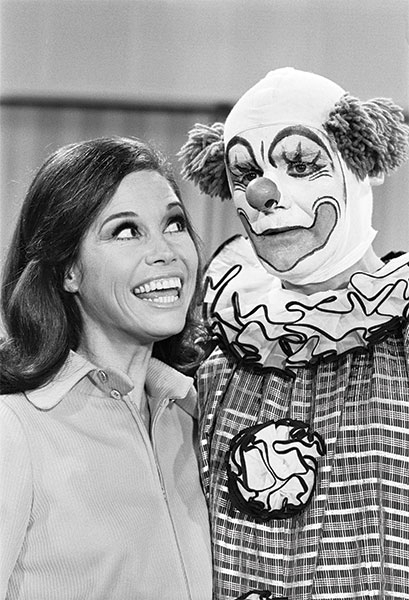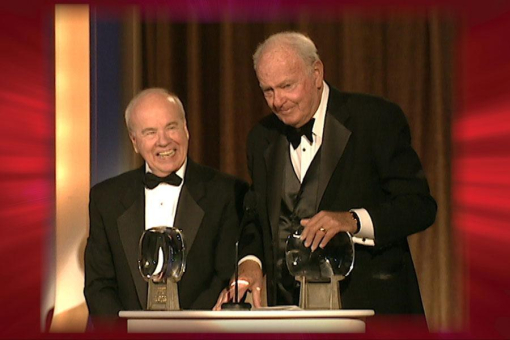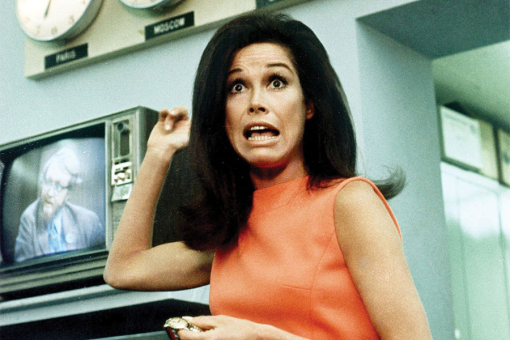As a young girl in Brooklyn, Mary Tyler Moore didn’t dream of acting.
She certainly couldn’t have imagined becoming a much-honored actress — or playing characters considered icons of American womanhood. No, Moore simply wanted to dance.
But fate intervened, almost from the day she graduated from high school, leading her to marriage, motherhood and a career in television — all before age 20. The daughter of a utilities company clerk and a homemaker who suffered from alcoholism, she turned as a youngster to an aunt and her grandmother (her “life preservers”) for help, comfort and dance lessons.
In 1961, six years after high school, fate again intervened when Danny Thomas remembered Moore from a previous audition and asked that she be brought in to read for the role of Rob Petrie’s wife, Laura, in The Dick Van Dyke Show.
While honing her comedy skills on the show, Moore contributed a vibrant real-life sensibility. She insisted on wearing capris, especially in household scenes — not the dresses and heels that were the norm of the day. While that show would bring her two of her six Emmy Awards, the lion’s share of her awards acclaim would come in the ‘70s with The Mary Tyler Moore Show.
In the comedy created by James L. Brooks and Allan Burns, she starred as a jilted, single woman pursuing a career in television news. In short order, it became one of the most-watched shows of the decade.
Moore died in January at age 80. During her life she struggled with Type I diabetes and suffered several tragedies; her son, Richard, died in 1980 at age 24 of an accidental gunshot to the head. Moore was interviewed by Diane Werts for the Television Academy Foundation’s Archive of American Television in 1997; the following is an edited excerpt of that conversation. The entire interview may be viewed at TelevisionAcademy.com/Archive.
Q: What was your dream? Did you want to be a great dramatic actress or musical personality or…?
A: I wanted to be a dancer — so much so that I will always feel I was a failed dancer rather than a successful actress. You don’t let go of those childhood dreams and images: Fred Astaire and Ginger Rogers and Leslie Caron and Cyd Charisse and all those happily-ever-after experiences that were brought home through dancing.
When we moved to Los Angeles, I started taking dance classes. My Aunt Birdie paid for them and drove me. My grandmother made costumes for the recitals. It was locked in my mind and heart and soul that it was what I was going to do.
When I graduated from high school, I got a pretty nifty job, but it didn’t last. I was Happy Hot Point, an elf, in a series of commercials for The Adventures of Ozzie and Harriet. I was the representative of the Hotpoint appliances. I talked to Harriet: “Hi Harriet, aren’t you glad you use Hotpoint appliances?” That was a tremendous step forward because that was truly a professional job — and I was able to dance in it.
Q: Did you expect that would lead to other things? You were already married at this point.
A: Yes, I had gotten married just a couple of months after high school. And I did expect that this would somehow lead to movies, that I would be able to do all those wonderful musicals I’d grown up with. But I got pregnant pretty quickly after I was married.
That was a difficult moment to live through — for the Hotpoint people, too — because pixies are supposed to be of neutral gender, and there I was, with these developing breasts in my little gray leotard and my perky little ears, not looking very much like the logo they had in mind. So that had to be truncated, and I went on to happily become Richard’s mother.
Q: How did you get your first regular role on television?
A: The first regular role was that of Sam, a rather sexy-voiced creature who was the answering-service woman for Richard Diamond, Private Detective, starring David Janssen. I was never fully seen. You would see a close-up of my mouth or a shot of my legs. They got really carried away with interesting ways to shoot this character so she would look terribly appealing, but you couldn’t really tell who she was.
It piqued the curiosity of men all over the world. It was an anonymous role for me, though, because the producers asked me to keep my identity a secret. After 12 episodes, I went to the producers and said, “I really think I should have a raise.” The role was getting a tremendous amount of attention and the ratings were going up.
Q: How did that go over?
A: Before they even found out how much I was going to ask for — which was 10 dollars more per show — they said, “We can easily do it with just about any actress, Mary, because you’ve never been seen.” So I was fired. And did I leave? I’m not sure.
Q: Meaning what?
A: I left that show, but I was able to reveal that I had been Sam on Richard Diamond. TV Guide would put in their columns, “Playing the role of Laura tonight in 77 Sunset Strip, will be Mary Tyler Moore, Sam of the Richard Diamond show.” And the ratings would always go up for that show. I continued to work and was cast in more and more roles.
Q: How did The Dick Van Dyke Show come about?
A: One afternoon I got a call from my agent, who said that the people at the Danny Thomas office wanted to see me for a show. I had been on four interviews that week and didn’t get any of them. So I said to my agent — and this was the only time I ever backed out — “You know what? I really don’t want to go. I can’t take another disappointment.” And he said, “Excuse me, but who am I talking to here?”
He eventually talked me into going. I was terrified because it was not only with Danny Thomas and Sheldon Leonard and Dick Van Dyke, but my hero, Carl Reiner, who was the writer-producer of the show.
Q: Had you met Carl Reiner before?
A: No.
Q: Had you done any comedic work before? Why did they think of you?
A: They thought of me because the year before, I had interviewed to play Danny Thomas’s daughter in Make Room for Daddy. Then it was called The Danny Thomas Show. I had been called in, with some 75 other girls, and it had been narrowed down to two of us.
Danny came over to me and said, “The reason you didn’t get the job was not because you’re untalented, but with a nose like yours, kid, no one would believe you’re my daughter.” A year later, when he was now looking for someone to play Dick Van Dyke’s wife, he remembered. He said, “Who was the kid? The one with three names and the funny nose.” And they did look me up and they remembered.
Q: What was the meeting with Carl Reiner like?
A: I sat down and picked up the script and somehow managed to get words to come out. About halfway through the scene, he placed his hand on my head and said, “Come with me.” He directed me down the hall to Sheldon Leonard’s office and said, “I want you to hear this.” He said, “Okay, do it again.” Afterwards, I had this feeling that everybody was pleased.
Q: What kind of restrictions did they put on you once the show was filming?
A: The network and the sponsors — the sponsors had a good deal more to say then — said that our characters had to sleep in twin beds, even though we were a married couple. We had to wear pajamas with the little pockets in the shirt. And we were not allowed to say “pregnant.” You had to say “expecting a child” or “expecting a baby.”
Q: Did they have any other issues or objections?
A: Well, their big objection was that I wore pants on the show. I had seen too many housewives on television who were vacuuming in high heels and a floral printed frock. I said, “That’s not the way it really is.” I wanted to be real. I was married and a mother, and I would walk around barefoot, as I still do, and I wore pants.
I also brought my sense of honesty, my sense of truth. I had a great appreciation for humor, but I had never thought of myself as a funny person. I knew I was in with the black belts of comedy, so I thought, “Well, I’ll hold my head up among them as a dramatic actress, and I’ll make sure they stay with the truth.”
Q: Did they appreciate that?
A: I drove poor Carl crazy. He would come up with some wonderful joke and I would say, “But Carl, I can’t say that…. Don’t you remember last week? That would be a contradiction. I know it’s a sure laugh, but we can’t do it.” He claims now, with all love and forgiveness and kindness, that I kept him honest and that he’s glad of it. And I think maybe that’s a little bit true.
Q: Looking back, the relationship between Rob and Laura seems very egalitarian.
A: Very egalitarian and very sexual. That was certainly a first, and that was a lot of fun. It came from Carl, in the writing. We might not have been talking about something sexual, but there would be a stage direction: “He puts his arm around her; she looks up at him and snuggles further into the embrace.” Those kinds of things hadn’t been in scripts before.
Q: What were some memorable episodes of The Dick Van Dyke Show for you?
A: When I went on the show, I had nothing but a dramatic background. I’d done dancing and singing and silly things and I loved musical comedy, but I didn’t know what I was doing.
Early on, Carl saw some spark of humor in me and wrote “My Blonde-Haired Brunette,” an episode in which Laura, feeling that Rob was no longer attracted to her, decided she was going to bleach her hair blonde — and it looked horrible. So, with Millie’s help, she tried to get it dyed back to brown before he got home, but she ended up getting only one half of her head dyed. And when Rob sees her and starts laughing, she starts to cry.
That episode proved I could handle comedy. From that show on, they began writing toward my ability to cry with humor.
Q: You shot in front of a live audience….
A: A live audience of about 300 people. Lucille Ball was our landlady — she owned Desilu. We’d be rehearsing on the set, absorbed in our work, and then we’d hear a laugh that wasn’t coming from the floor. We’d look up, and there she was on the catwalk, that sort of rope ladder that the lighting guys use to hang their lights. She’d be up there watching us.
She’d come down and talk to Dick and say, “Yeah, I saw the show last week and it was really great. You are so funny.” She had something nice to say about everybody.
And I will never forget, one day she had walked out of the studio but then she came back, came up to me and said, “You’re very good.” That was the greatest gift I ever received in this business. I don’t think I have another moment that compares with the impact of those words.
Q: How did it feel when you won your first Emmy in 1964? That was certainly recognition of your drive and success.
A: Winning an Emmy is a great feeling. And psychologically, it’s no wonder that people weep when they get this symbol of achievement. That moment represents all the supposed failures that you feel you have had. And it’s not only recognition of what you’ve achieved, but it’s hope for the future.
Q: Let’s discuss the development of The Mary Tyler Moore Show — how was it decided what the show would be about?
A: Unfortunately, I was very reticent to get involved. My comportment back then was to surround myself with greatness and then let them do the work. I didn’t really venture forth with anything in particular — I preferred being merely an actress.
Grant [Tinker, Moore’s husband at the time] brought in Jim Brooks and Allan Burns together as a team, and they had never written together before. I don’t know if they even knew each other. But he somehow felt that it would be a good combination.
We had a meeting and I said, “I think from my experience on The Dick Van Dyke Show that it’s smart for me to play somebody who’s close to my own persona, so that I don’t have to create a character and then try to match that character week after week.”
They agreed and said, “We’re thinking maybe she works in a small television station and that she’s looking to be married, but she’s not desperate about it.” I said, “That sounds good, too. I like that because that’s kind of progressive.” And then they said, “And we think she’s probably coming off a divorce where she lived in Roseville, Minnesota, and then moves to Minneapolis.”
Q: Was anyone at CBS involved in those discussions?
A: As soon as CBS heard that premise, they hit the ceiling. They said, “You can’t have Mary divorced from somebody. Even if she does have a different last name, they’re going to think she divorced Dick Van Dyke. That can’t happen.”
They changed it to a situation where my character had been supporting my fiancé, a would-be doctor, through medical school, who then dumped me after he set up practice. I found it terribly distasteful, but apparently CBS thought that was preferable to being divorced.
Q: What was done to make sure that Mary Richards wasn’t Laura Petrie?
A: It wasn’t very complicated. I wore a wig. The first year of the show I had this voluminous long brown hair, because on the Dick Van Dyke Show I’d worn it short and in that flip. That was the only thing I could think of to make her separate from Laura. Then, in the second year, I guess I got a little more confident, so I went back to just wearing my own hair. But if you see any of those early episodes from the first year, you’ll see that I don’t feel comfortable turning my head because of that wig. I was never able to relax.
Q: This was very much an ensemble show. Was that your decision?
A: You bet.
Q: How was the ensemble compiled?
A: The credit there especially goes to Jim Brooks and Allan Burns, because they had created characters in their minds, but they were open to suggestion. One of the very strong suggestions was Ted Knight, who came in to audition for the part of Ted Baxter, the anchorman.
In their minds, Ted Baxter was supposed to be tall, dark and handsome. Maybe not Walter Cronkite, but a love interest for Mary. Then they saw Ted Knight. And with all his pomposity and his bluster, they decided to just leap at the opportunity that Ted offered them. They hired him immediately.
It takes really confident people who care about the result to let go of their first dream and go with somebody else’s idea.
Q: What do you remember about the first episode?
A: We did a run-through of the script on a Wednesday night for an audience. We were counting on the reaction to tell us what we had. And they didn’t like it. They didn’t laugh at anything. We were all devastated. I went home and I cried myself to sleep.
I said to Grant, “They’ve got to fix it.” This was my hope, my dream, my life. He went into the other room and he made a call to Jim and Allan, who were still in the writers’ room. He said, “Fix it,” and hung up the phone.
Q: What changed?
A: They made only a few minor changes. I don’t know specifically what they were. They had little Bess, Phyllis’s daughter, come in and like Rhoda. That interaction between them made Rhoda seem acceptable. Some of the audience members who had filled out cards had said that they didn’t like that Rhoda was mean to Mary. So they figured that if a child liked Rhoda, then she wasn’t all mean.
That following Friday we did the very same show, and it went through the roof. It was a huge success.
Q: The episode I think that everyone remembers, where Mary had an interesting reaction, was “Chuckles Bites the Dust.” You won an Emmy for it.
A: That’s not my favorite episode, but it did me a lot of good. And I think it is everybody’s favorite. That was the show in which Chuckles the Clown, who’d been dressed as a peanut in a parade, is killed by a rogue elephant who was trying to shell him.
The death is a loss to all of us at the station, but — as sometimes happens — to cover the pain people are feeling, they will make jokes: “Well, thank God, the elephant wasn’t hungry because, you know, one peanut, and then you want more and more.” Everyone would laugh and Mary would be incensed and say, “How can you do that? You have no sensitivity.”
Q: What do you remember about the filming of that episode?
A: There was an interesting thing that was happening as we rehearsed the show — it sort of paralleled the script. Every time I had to refer to Chuckles — and I had to say it several times — as Mr. Fee-Fi-Fo, I would lose it. I started laughing. I wasn’t sure that I was going to be able to get through it without laughing, which would have destroyed our show.
The punch line was at the memorial: the minister is reminiscing about Chuckles’s characters, and Mary starts laughing. It would have been impossible if I had laughed earlier. But I made it through the show, and it’s been admired by a lot of people.
Q: How many times did you have to throw the tam in the opening credits?
A: I think, thankfully, just the once, because it really was a spur of the moment idea. We were out there in the middle of February in Minneapolis, freezing, so cold that I couldn’t speak. My lips wouldn’t form words. But they just wanted shots of me in action.
I was in front of a department store and they said, “Run out into that intersection and take your hat” — which I had in my hand — “and throw it up in the air as though this is the happiest moment of your life.” I did, and that was it.
Q: It’s an iconic moment.
A: A metaphor for every young person starting out.
Q: Tell us about the filming of the last episode.
A: It’s amazing that any of us got through it without sobbing. Every writer who had ever written more than one episode of The Mary Tyler Moore Show was asked to participate. I can’t imagine how they wrangled it all in the writers’ room. But Jim and Allan had some input and they came together with a pretty wonderful script.
My favorite moment from that show was the group hug, which came about spontaneously, during rehearsal.
There we were, all embracing each other, and somebody said, “We need a Kleenex,” and Georgette’s [Georgia Engel] line was, “Well, there’s a Kleenex box on Mary’s desk.” And then somebody said, “The question is, how do we get to it?” And somehow we all did that little group step. In the script, it was written: “They break up and they go to the Kleenex.” But wasn’t that a pot of gold, huh?
Q: What was the first thing you did after that series, to break the TV Mary mold?
A: The film Ordinary People. That was such a change of pace, that a woman could be so brittle inside that she could alienate her son. I saw her as a victim. I saw her as very reminiscent of my own life, and I felt I had to do that role.
I thank God for [director] Robert Redford, who had the vision to believe that I could. I don’t know how he knew that, but he said that when he first read the book, he had me in mind for it. After we had this first talk about it, he spent three months auditioning every actress in town, but he came back to me.
Q: What has been your biggest triumph?
A: Longevity. I think it’s that I endured The Dick Van Dyke Show and The Mary Tyler Moore Show and several special moments thereafter. And the legacy of those series lives on for viewers even today.
This article originally appeared in emmy magazine, Issue No. 4, 2017














